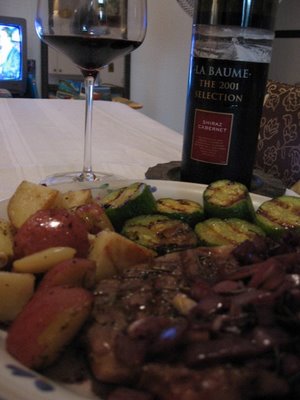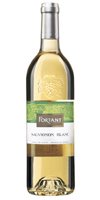Anytime wine: O'Terra (formerly Opus Terra) Les Vignerons des Tourelles Merlot Syrah 2005

O'Terra is short for Opus Terra, but you can't really say that since some Californian heavyweights in the wine world have taken over official ownership of the word Opus since the mid-eighties.
When the Vignerons des Tourelles in Languedoc-Rousillon created this cuvée in the nineties, its label (which happens to be the one on the bottle shown above) was considered as infringing on the copyright of the winery, which is Opus One. As an outcome of the legal dustup, Tourelles had to settle for naming their wine O'Terra.
In Quebec, there is no Opus One wine currently for sale. When there was, it was priced at $264. The "opus" of a cuvée that the Vignerons des Tourelles make is $251 cheaper. No wonder Opus One was worried!
I've never tasted any wine carrying the Opus One brand -- I'm sure it'd be hard to compare it to O'Terra Vin de Pays d'Oc 2005, but I think it goes without saying that this bottle here is the anytime wine that Opus One is not.
Anytime wine is a great thing. It's the wine I described in the last post. Only the most difficult-to-pair dish would not be done justice by this savoury, oak-free, fruit-driven red wine. It's not meant to age however, so when I say it's anytime wine I mean anytime this year or next.
O'Terra is 60% Merlot and 40% Syrah. This balance is perfect. It renders tannic values to an exceptably low level for lighter fish dishes; it adds complexity to a flavour profile that is expressive enough to come across whether it served with steak or duck.
What else can I say? I most often think of opening a Loire red for my favourite dinners. But the times in between special dining occasions are more than well-served by this fantastic $13 bottle.
Eyes: A clear red with medium depth.
Nose: Fairly aromatic. It suggested cherry pie to me. Some yeasty notes with alluring red berry aromas.
Mouth: Crisp and refreshing attack with plums in a savoury spice. Tremendous brightness with a dry and light-to-medium body. Intense flavours supported by some round tannin. The finish is somewhat weaker than the attack. Simple but so expressive.
Stomach: A food-friendly package has been delivered to you. I had this with tuna casserole one night, red meat the next. Pork, poultry, salmon, why not? Lamb might not be the perfect match, but it would work.
You also might take Michel Phaneuf's word on this wine since it's been given high praise for a number of consecutive years, even in the troublesome 2002 vintage.
I particularly appreciate Malcolm Anderson's review despite being for a vintage that has long passed. I last tasted this version four to five years ago, yet it still sounds pleasantly familiar:
I really liked this wine’s blend of merlot and syrah. It had a leathery, animal, earthy nose and delightful blackberry fruit on the palate with a complexity rarely seen in a wine of this price. The wine has no oak aging - you taste what the grapes and the winemaker gave you. the wine has enough tannins to add interest to the palate but they are the softer grape tannins imparted by the skin and are easy to handle. If you are lucky enough to have any remaining turkey leftovers at this date, defrost them for this excellent wine. Wine of the week ****
Malcom Anderson - The Gazette - Jan. 11, 2003
Beaucaire, Gard, France. 14%.


















